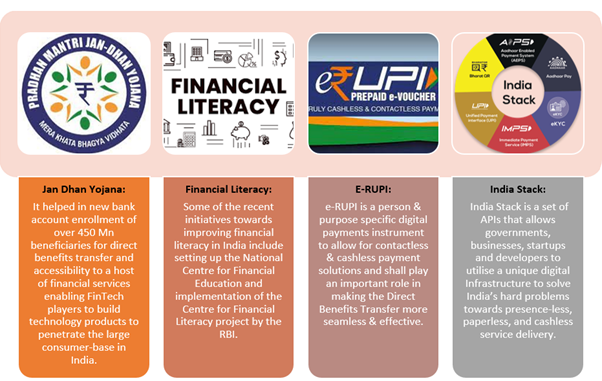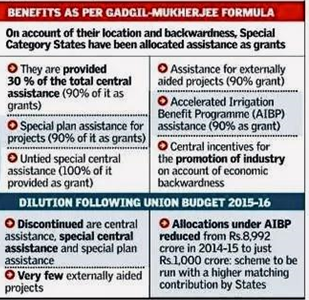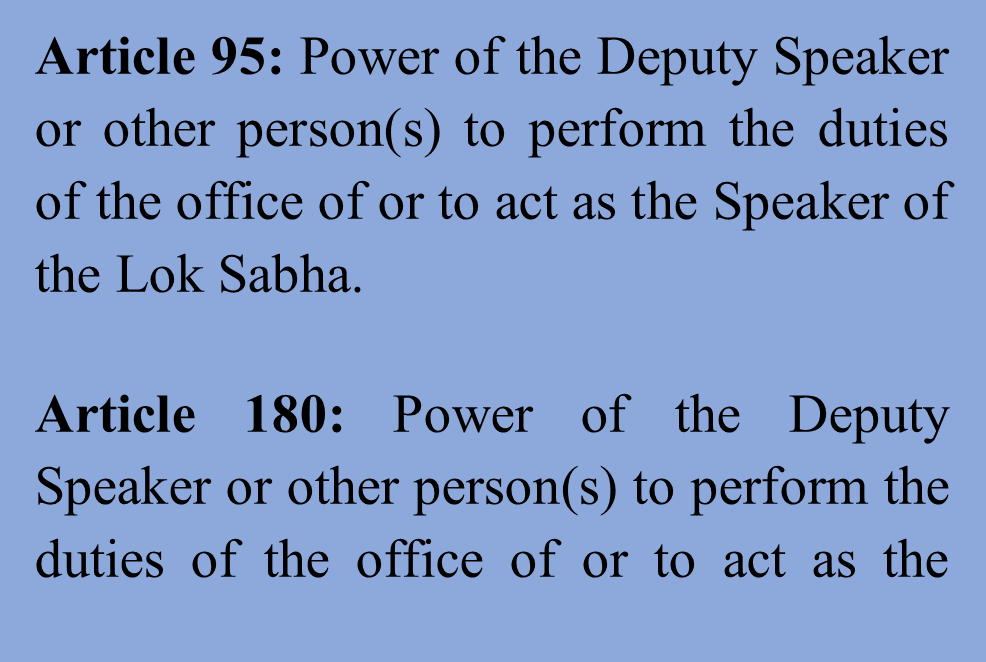Monday, 27th February 2023
Crypto assets action plan - Edukemy Current Affairs
In News:
The International Monetary Fund (IMF) has laid out a nine-point action plan for how countries should treat crypto assets, with a plea not to give cryptocurrencies such as bitcoin legal tender status.
About the News:
- The IMF’s Executive Board had discussed a paper, "Elements of Effective Policies for Crypto Assets," that provided "guidance to IMF member countries on key elements of an appropriate policy response to crypto assets."
- Such efforts have become a priority after the collapse of a number of crypto exchanges and assets over the last couple of years.
- The recommendations were to:
- Safeguard monetary sovereignty and stability by strengthening monetary policy frameworks;
- Not grant crypto assets official currency or legal tender status;
- Guard against excessive capital flows;
- Establish international arrangements to enhance supervision and enforce regulations;
- Monitor crypto's impact on the stability of the global monetary system;
- Adopt unambiguous tax rules and laws around crypto assets; and
- Develop and enforce oversight requirements for all crypto market actors.
- The IMF had criticised El Salvador in late 2021 when the central American country became the first to adopt bitcoin as legal tender, a move that has since been copied by the Central African Republic.
What are crypto assets?
Crypto assets are purely digital assets that use public ledgers over the internet to prove ownership.
- They use cryptography, peer-to-peer networks and a distributed ledger technology (DLT) such as blockchain to create, verify and secure transactions.
- They can have different functions and characteristics:
- they may be used as a medium of exchange;
- a way to store value;
- or for other business purposes.
- Crypto assets generally operate independently of a central bank, central authority or government.
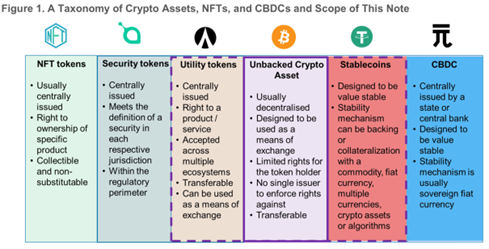
What is a cryptocurrency?
Cryptocurrency (or virtual currency) is likely the most well-known type of crypto asset. Cryptocurrency is a digital currency or medium of exchange.
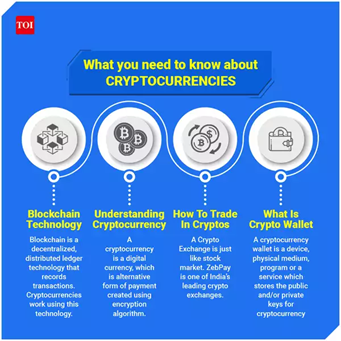
- It can be used:
- To exchange for products or services, like fiat currency (such as Canadian dollars or US dollars)
- For speculative purposes, such as trading on a crypto asset trading platform (CTP)
- As a store of value
- It was created as an alternative to fiat money, but cryptocurrency is not considered legal tender in Canada.
- Cryptocurrencies have no inherent value; their perceived value is based largely on supply and demand in the market. Examples include Bitcoin, Ether, Ripple and Litecoin.
- Cryptocurrencies are generally not considered to be securities and, therefore, are generally not subject to securities laws.
What is a distributed ledger?
A distributed ledger is a type of database that stores electronic records shared and replicated across many locations and maintained by members of this decentralised network.
- Each new transaction must be agreed upon by all members of the network before it is added to the ledger.
- Blockchain is one type of distributed ledger that arranges the data in chunks and chains them together. This unique way of structuring data gives blockchain transactions additional security as they are irreversible. Blockchains can be used to store many types of data but have recently become popular for their use of storing cryptocurrency transaction history.
Source:
https://www.hindustantimes.com/business/imf-rolls-out-nine-point-crypto-assets-action-plan-advises-against-legal-tender-status-101677206532387.html
5th Annual Periodic Labour Force Survey - NSO
In News: As per government survey, Unemployment rate dips in 2022.
Context:
- Considering the importance of availability of labour force data at more frequent time intervals, National Sample Survey Office (NSSO) launched the Periodic Labour Force Survey (PLFS) in 2017.
- As per the recent survey, Joblessness was high in October-December 2021 mainly due to the staggering impact of Covid-related restrictions in the country.
- The objective of PLFS is primarily to estimate the key employment and unemployment indicators (viz. Worker Population.
- It also gives Ratio, Labour Force Participation Rate, Unemployment Rate) to estimate employment and unemployment in both rural and urban areas annually.
- All data has been compiled for persons aged 15 years and above.
- The present quarterly bulletin is the seventeenth in the series for the quarter October–December 2022.
Major findings:
|
Parameters |
Findings |
|
Unemployment rate |
|
|
Labour force |
|
|
Labour force participation (LFPR) |
|
Major issues:
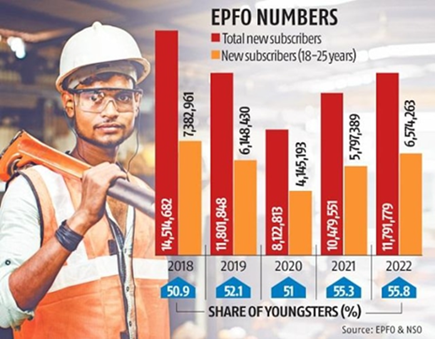
- The latest quarterly Periodic Labour Force Survey (PLFS) puts the youth unemployment rate almost more than twice the overall unemployment rate (7.2 per cent) which is a cause for concern.
- Employment creation is still 6 per cent lower than pre-pandemic levels with dip in new subscribers joining the EPFO scheme highlighting decline in creation of new jobs.
- As per the Global Employment Trends for Youth 2022 report of the International Labour Organisation pandemic had worsened the numerous labour market challenges facing those aged 15-24 years.
- Younger ones in this group have been experiencing a much higher percentage loss in employment than adults since early 2020.
What can be done?
- Centre should push states to introduce labour codes 'as soon as possible'
- Government can also scrap outdated labour codes, convene conference to remove bottlenecks in the trade process in context of labour issues.
- There is need for administrative labour reforms over legislative ones to help employers adapt to new global challenges in business.
|
Key Terms |
|
https://www.business-standard.com/article/economy-policy/unemployment-rate-dips-to-7-2-in-october-december-2022-govt-survey-123022401202_1.html
FATF suspends Russia’s membership
In News:
Global financial crime watchdog Financial Action Task Force (FATF) suspended Russia's membership stating the reason that Moscow's war in Ukraine violated the organisation's principles.
About:
- This is the first time a member of FATF is suspended. Although suspended, Russia remains a FATF member. Russia will be barred from attending meetings and accessing documents.
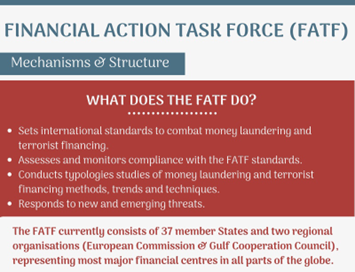
About FATF:
- It is an inter-governmental organisation established in 1989 and is based in Paris.
- Ukraine is not a member of FATF.
- Black List document: High-Risk Jurisdictions subject to a Call for Action
- It identifies countries or jurisdictions with serious strategic deficiencies to counter money laundering, terrorist financing, and financing of proliferation.
- For all countries identified as high-risk, the FATF calls on all members and urges all jurisdictions to apply enhanced due diligence.
- In the most serious cases, countries are called upon to apply counter-measures to protect the international financial system from the ongoing money laundering, terrorist financing, and proliferation financing risks emanating from the country.
- Democratic People’s Republic of Korea, Iran and Myanmar fall in this list.
- Grey List document: Jurisdictions under Increased Monitoring
- It identifies countries that are actively working with the FATF to address strategic deficiencies in their regimes to counter money laundering, terrorist financing, and proliferation financing.
- When the FATF places a jurisdiction under increased monitoring, it means the country has committed to swiftly resolve the identified strategic deficiencies within agreed timeframes and is subject to increased monitoring.
- Philippines, United Arab Emirates, South Africa etc are included in this list.
Source:
https://www.reuters.com/world/europe/financial-crime-watchdog-fatf-suspends-russias-membership-over-ukraine-war-2023-02-24/
Foundational Literacy and Numeracy report
In News:
The Foundational Literacy and Numeracy report by the Economic Advisory Council to the Prime Minister (EAC-PM) has highlighted the focus on language as a critical foundational skill.
About:
- The National Education Policy 2020 envisioned the Foundational Literacy and Numeracy report.
- The report has highlighted the need to undertake various assessments pertaining to the linguistic system and focus on improving the sample size for assessing learning outcomes effectively.
- It also focuses on the National Initiative for Proficiency in Reading with Understanding and Numeracy, NIPUN.
Importance of the Foundational Literacy and Numeracy report:
- The report is a benchmark for states and union territories to track their performance relative to their peers in achieving universal foundational learning by 2026-27.
- The report’s findings cover the role of nutrition, access to digital technology and language-focused instructional approach.
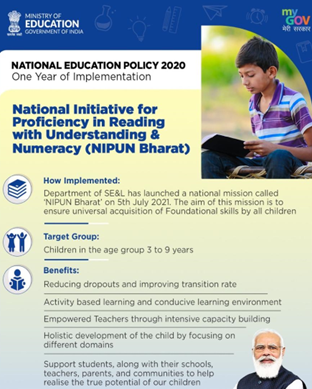
Source:
https://www.livemint.com/news/india/foundational-literacy-and-numeracy-report-highlights-focus-on-language-as-critical-skill-11677236052785.htmlhttps://www.scientificamerican.com/article/another-patient-is-free-of-hiv-after-receiving-virus-resistant-cells/
Stem Cell Transplant - Edukemy Current Affairs
In News: An old man in Düsseldorf, Germany has been declared HIV-free after a bone marrow transplant of cells resistant to the virus.
Context:
- The stem-cell technique used was first used to treat Timothy Ray Brown, known as the Berlin patient, and the London patient, Adam Castillejo, who were both declared HIV-free after the procedure.
- HIV is caused by a virus which can spread majorly through sexual contact, illicit injection drug use or sharing needles, contact with infected blood.
- It can also spread from mother to child during pregnancy, childbirth or breastfeeding.
- It destroys CD4 T cells — white blood cells that play a large role in helping your body fight disease.
- The Düsseldorf patient had extremely low levels of HIV due to antiretroviral therapy (ART) when he was diagnosed with acute myeloid leukaemia.
Key points:
- The procedure involves selecting a donor with a genetic mutation called CCR5Δ32/Δ32, which makes cells effectively resistant to the virus.
- The latest patient stopped taking ART in 2018 and has remained HIV-free since.
- The risk associated with the bone marrow transplant used to treat HIV means the procedure is unlikely to be widely used in its current form.
- Several teams are testing the potential to use stem cells taken from a person's own body and then genetically modified to have the CCR5Δ32/Δ32 mutation, which would eliminate the need for donor cells.
- In some cases, the virus mutates inside a person and finds other ways to enter their cells.
- It is also unclear whether chemotherapy that the people received for their cancer before their bone marrow transplants might have helped to eliminate HIV by preventing infected cells from dividing.
https://www.scientificamerican.com/article/another-patient-is-free-of-hiv-after-receiving-virus-resistant-cells/
New EPFO guidelines for pension
In News: The Employees’ Provident Fund Organisation (EPFO) has recently put out a new set of guidelines for employees and pensioners for higher pension.
Major highlights:
- As per the new guidelines, existing employees and those who have retired after September 1, 2014 can opt for higher pension.
- Also, Employees and employers who contributed on salary exceeding the wage ceiling of ₹5,000 or ₹6,500 besides those who did not opt for the joint option in the previous window while being EPS members.
- The new guidelines allow employees to deduct 8.33% of their actual basic salary towards the EPS, leading to a larger corpus and a higher pension.
- The EPS contribution from employees is currently capped at ₹15,000 for pensionable salary.
- To avail the new benefit, employees need to jointly apply with their employer in the new pension form prescribed by the EPFO commissioner, along with all other required documents like joint declaration.
- All applications will have to be digitally uploaded, for which a separate URL will be provided.
- An email and an SMS will be sent to the applicant informing about their switch.
- The new pension will be based on actual salary beyond the earlier prescribed range under Employees’ Pension Scheme (EPS) of 1995.
https://www.thehindubusinessline.com/news/variety/everything-you-need-to-know-about-the-new-epfo-guidelines/article66536439.ece
Phosphor-Gypsum in National Highway Construction
Why in news? Recently, NHAI uses Phosphor-Gypsum in National Highway construction to achieve a circular economy in the use of Gypsum.
About:
- Phosphor-Gypsum, a waste product from manufacturing fertilizer, emits radon, a radioactive gas. It also contains the radioactive elements uranium, thorium and radium.
- The use of Phosphor-Gypsum in road construction aligns with the principles of a circular economy. This process encourages the use of waste material to create new products, thus reducing waste and conserving resources.
- Ministry: National Highways Authority of India (NHAI), Department of Fertilizers and Ministry of Chemicals & Fertilizers
Other Initiative:
- Use of Plastic: NHAI is also encouraging the use of waste plastic in road construction, which has been tested very successfully. Studies have established that roads built using plastic waste are durable, sustainable and increase the life of bitumen (a substance produced through the distillation of crude oil).
- Use of Fly Ash: NHAI has used Fly Ash for the construction of Highways and flyover embankments. Fly ash is an unwanted unburnt residue of coal combustion in a coal thermal power plant.
National Highways Authority of India (NHAI) along with the Department of Fertilizers, Ministry of Chemicals & Fertilizers will take up field trials on NHAI projects for the use of Phosphor-Gypsum in National Highway construction to achieve a circular economy in the use of Gypsum.
https://pib.gov.in/PressReleasePage.aspx?PRID=1901441
Singareni Thermal Power Plant (STPP)
Why in news? Singareni Thermal Power Plant (STPP) in Telangana is set to become the first public sector coal-based power generating station in the South.
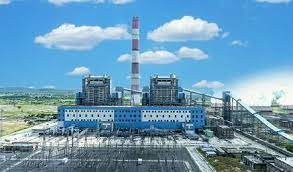
About:
- STPP is also set to become the first among the State PSUs in the country to have a flu gas desulphurization (FGD) plant.
- With 100% utilisation of the fly ash generated, the STPP has won the best fly ash utilisation award twice.
FGD Plant
- The FGD plant would process the sulphur and other gases (nitrogen oxides) generated in firing the coal for power generation.
- The FGD plant removes Sulphur Dioxide from the flue gas before it is released into the atmosphere and hence reduces its impact on the environment.
- FGD systems are characterized as either “wet” or “dry” corresponding to the phase in which the flue gas reactions take place.
https://www.thehindu.com/news/national/telangana/stpp-set-to-become-first-public-sector-thermal-plant-in-south-to-have-fgd-facility/article66535952.ece
Russia Suspends New START - Edukemy Current Affairs
Why in news? Recently, Russia has announced to suspend its participation in the New START, the last remaining major military agreement with the United States.
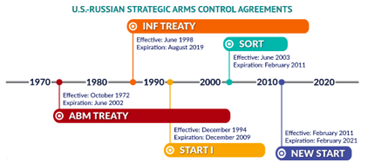
About:
- The name START comes from the original “Strategic Arms Reduction Treaty”, known as START-I, which was signed between the US and the erstwhile USSR in 1991, and came into force in 1994.
- The New START, the “Treaty between the United States of America and the Russian Federation on Measures for the Further Reduction and Limitation of Strategic Offensive Arms”, entered into force on 5th February 2011, and placed new verifiable limits on intercontinental-range nuclear weapons.
- The two countries had to meet the treaty’s central limits on strategic offensive arms by February 2018, and to then stay within those limits for the period the treaty remained in force. The US and Russia Federation subsequently agreed to extend the treaty through February 2026.
https://indianexpress.com/article/explained/explained-global/russia-suspends-new-start-what-is-its-last-remaining-nuclear-arms-treaty-with-us-8458806/
Mad Cow Disease - Edukemy Current Affairs
Why in news? Recently, Brazil has halted its beef exports to China after a case of Mad Cow Disease was confirmed in the northern state of Para.
About:
- Mad Cow Disease is also known as Bovine Spongiform Encephalopathy (BSE) is degenerative, transmissible, slowly progressive, and a fatal infection that affects the central nervous system of adult cattle.
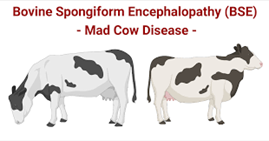
- Causes:
- BSE is caused by a protein called a prion normally found on cell surfaces, the normal prion protein changes into an abnormal prion protein that is harmful.
- After getting altered, these proteins destroy the nervous system tissue- the brain and spinal cord.
- Transmission:
- A cow gets BSE by eating feed contaminated with parts that came from another cow that was sick with BSE.
- Symptoms:
- A sick cow has trouble walking and getting up and may also act very nervous or violent.
- It usually takes four to six years from the time a cow is infected with the abnormal prion to when it first shows symptoms of BSE. This is called the incubation period.
- Once a cow starts to show symptoms, it gets sicker and sicker until it dies, usually within two weeks to six months.
- Treatment:
- There is no treatment for BSE and no vaccine to prevent it.
https://www.hindustantimes.com/world-news/mad-cow-disease-details-mad-cow-disease-case-halts-brazil-s-beef-exports-to-china-what-is-it-101677111465819.html
Garcinia Pedunculata - Edukemy Current Affairs
Why in news? Garcinia pedunculata, a medicinal plant commonly called 'Borthekera' in the Assamese language, traditionally forbidden for raw consumption, has been found to protect from heart diseases.

About:
- The dried pulp of the ripe fruit of the medicinal plant reduced cardiac hypertrophy indicators and oxidative stress and heart inflammation brought on by International Organization for Standardization (ISO).
- It is a rich source of antioxidants.
- The sun-dried slices of the ripe fruit are used for culinary and medicinal purposes and are known to have therapeutic properties like anti-inflammatory, anthelmintic, antibacterial, antifungal, antidiabetic, hypolipidemic, nephroprotective, and even neuroprotective activity.
- Traditionally forbidden for raw consumption, in Assam, dried slices are used for preparing delicacies like "Tenga Diya Masor Jol" (sour fish curry).
- A traditional Assamese home also used to soak it in water and the liquid as home-remedy for stomach problems.
ISO
- ISO is an independent, non-governmental international organization with a membership of 167 national standards bodies.
https://pib.gov.in/PressReleasePage.aspx?PRID=1902039
PM Lauds Army Doctors for 3D Skull Repair
Why in news? Recently, Prime Minister has praised team of doctors of Central Command India army for rehabilitating a young patient's skull defect using advanced 3D printing technology for titanium cranioplasty repair.
About:
- 3D printing or additive manufacturing (AM) is a process of making three dimensional solid objects from a digital file. 3D printing is the opposite of subtractive manufacturing which is cutting out/hollowing out a piece of metal or plastic with, for instance, a milling machine.
Process of 3D Printing:
- The process starts with making a virtual design of the object that has to be created.
- This virtual design is made in a CAD (Computer Aided Design) file using a 3D modelling program (new object) or using a 3D scanner (existing object).
- Slicing software slices the final model into hundreds or thousands of horizontal layers. When this prepared file is uploaded in the 3D printer, the printer creates the object layer by layer.
- The 3D printer reads every slice (or 2D image) and proceeds to create the object blending each layer together with no sign of the layering visible, resulting in one three-dimensional object.
Applications:
- The 3D printing technology is used for both prototyping and distributed manufacturing with applications in architecture, construction, industrial design, automotive, aerospace, dental and medical industries, biotech (human tissue replacement), fashion, jewellery, education, geographic information systems and many other fields.
https://pib.gov.in/PressReleaseIframePage.aspx?PRID=1901588
Social stock exchange (SSE) - Edukemy Current Affairs
Why in news? Recently, NSE has got the final Securities and Exchange Board of India (SEBI) approval to launch Social Stock Exchange.
About
- The idea of a social stock exchange was first mooted in the Union Budget 2019-20 to enable entities involved in social activities such as charitable trusts and non-profit organisations (NPO) to access the capital market for funds.
- It works under the market regulator SEBI.
Aim
- To provide new avenues for social enterprises to finance social initiatives, provide them visibility, and bring in increased transparency in fund mobilisation and utilisation.
Eligibility:
- Any social enterprise, Non-Profit Organization (NPOs), or For-Profit Social Enterprise (FPE) that establishes its primacy of social intent can get registered/listed on the SSE segment.
- Corporate foundations, trade associations, political and religious organisations, infrastructure companies are not eligible to list on social stock exchange.
Function
- The SSE will allow social enterprises to raise capital as equity, debt, or as units like a mutual fund.
- The minimum issue size is set at INR 1 crore, and the minimum application size for subscription is INR 2 lakhs for Zero Coupon Zero Principal (ZCZP) issuance.
- It may be listed on National Stock Exchange (NSE) or Bombay Stock Exchange (BSE).

https://www.moneycontrol.com/news/business/markets/nse-gets-the-final-sebi-approval-to-launch-social-stock-exchange-10147071.html
National Data & Analytics Platform (NDAP)
Why in news? The government of India is drawing up a data ecosystem (through NDAP) thus enabling policy-makers and researchers to exploit the potential of public data.
About
- NDAP was launched in 2022 by NITI Aayog in collaboration with different ministries and state governments in India.
- NDAP aims to democratize access to public government data by making it accessible, interoperable, interactive, and available on a user-friendly platform for various stakeholders such as policymakers, civil servants, university students and researchers, journalists, innovators, and civil society groups.
- It hosts foundational datasets from various government agencies, presents them coherently, and provides tools for analytics and visualization.
- It has been part of the State Support Mission of NITI Aayog.
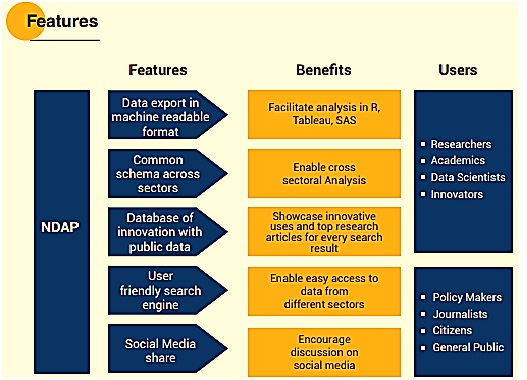
https://indianexpress.com/article/opinion/columns/parameswaran-iyer-and-v-anantha-nageswaran-write-giving-data-its-due-8461357/
Virtual Trade Corridor - Edukemy Current Affairs
Why in news? India and the UAE are exploring creating a virtual trade corridor to facilitate quicker clearance of shipments.
About
- A virtual trade corridor is an online platform that enables faster and more efficient customs clearance for international trade between two countries.
- Under the corridor proposal, the customs authorities of the two countries will explore the possibility of accessing pre-arrival information for cargo movement.
- It will make cross-validation of information significantly faster, besides facilitating pre-clearance of goods.
- This will complement the bilateral comprehensive free trade agreement signed between India and the UAE in 2022.
- It immediately eliminated duties on 90% of India’s exports in value terms and covered sectors like gems and jewellery, textiles, leather, and engineering goods.
https://www.livemint.com/news/india/india-uae-explore-virtual-trade-corridor-to-fast-track-shipments-11677091187367.html
Share the article
Get Latest Updates on Offers, Event dates, and free Mentorship sessions.

Get in touch with our Expert Academic Counsellors 👋
FAQs
UPSC Daily Current Affairs focuses on learning current events on a daily basis. An aspirant needs to study regular and updated information about current events, news, and relevant topics that are important for UPSC aspirants. It covers national and international affairs, government policies, socio-economic issues, science and technology advancements, and more.
UPSC Daily Current Affairs provides aspirants with a concise and comprehensive overview of the latest happenings and developments across various fields. It helps aspirants stay updated with current affairs and provides them with valuable insights and analysis, which are essential for answering questions in the UPSC examinations. It enhances their knowledge, analytical skills, and ability to connect current affairs with the UPSC syllabus.
UPSC Daily Current Affairs covers a wide range of topics, including politics, economics, science and technology, environment, social issues, governance, international relations, and more. It offers news summaries, in-depth analyses, editorials, opinion pieces, and relevant study materials. It also provides practice questions and quizzes to help aspirants test their understanding of current affairs.
Edukemy's UPSC Daily Current Affairs can be accessed through:
- UPSC Daily Current Affairs can be accessed through Current Affairs tab at the top of the Main Page of Edukemy.
- Edukemy Mobile app: The Daily Current Affairs can also be access through Edukemy Mobile App.
- Social media: Follow Edukemy’s official social media accounts or pages that provide UPSC Daily Current Affairs updates, including Facebook, Twitter, or Telegram channels.


